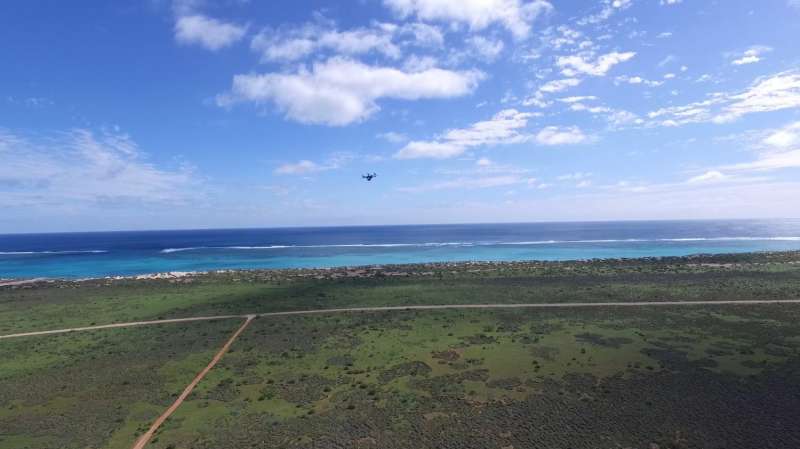QUT's hyperspectral camera takes off for Ningaloo Reef. Photo: QUT REF
Meet the new face of environmental monitoring – a combination of unmanned aerial vehicles (UAV) and a highly specialised camera that was once so big and expensive only satellites and airplanes could carry them.
QUT remote sensing researchers and UAV engineers are pioneering the use of new miniaturised hyperspectral cameras to monitor the health of Australian landscapes in more detail than ever before.
Project leader Associate Professor Felipe Gonzalez said his team was among the first in the world to obtain aerial hyperspectral imagery of a coral reef in extraordinary resolution – the pristine Ningaloo Reef at the Ningaloo Coast World Heritage site in Western Australia - in a data-gathering mission that will help inform future research.
"Normal cameras record images in three bands of the visible spectrum – red, green and blue – mixing those bands together to create colours as humans see them," said Professor Gonzalez, from QUT's Institute for Future Environments (IFE).
"By comparison, the hyperspectral camera captures 270 bands in the visible and near-infrared portions of the spectrum, providing far more detail than the human eye can see.
"And, as we're flying it on small UAVs at 30-100m over the water, the data collected is of an incredibly high resolution."
At 290 kilometres, Ningaloo Reef is one of the longest and structurally complex nearshore reefs in the world.
Professor Gonzalez said new lightweight hyperspectral cameras would open many possibilities for reef monitoring and collaborations with marine researchers.
IFE researchers are already working on integrating a hyperspectral camera unit into an underwater housing for marine robots.
"UAVs are a cost-effective sensor platform and a great complementary tool to existing satellite, manned aircraft and underwater surveys," Professor Gonzalez said.
"Large-scale, high-altitude surveys of the Ningaloo and Great Barrier reefs may lack the resolution necessary to identify individual corals, so this is the niche for low-altitude UAV surveys."
Using data collected by engineers in the IFE's Research Engineering Facility (REF), Professor Gonzalez and his team are developing revolutionary software to quickly analyse the airborne hyperspectral information from Ningaloo reef, and for a wide range of other environmental purposes, including detecting invasive plants in Western Australia and diseases in wheat crops.
Credit: Queensland University of Technology
The system is backed by a state-of the-art, REF-designed and manufactured gimbal that enables stabilised image capture from the hyperspectral camera onboard QUT's unmanned aerial vehicles.
QUT research engineer Dr Dmitry Bratanov said the hyperspectral UAV system surveyed approximately 40ha of Ningaloo Reef in 30 minutes at a flight height of 100m.
"This provides us with a spatial resolution of approximately 15cm per pixel – more than enough detail to detect and monitor individual coral species" Mr Bratanov said.
"The really special thing about the hyperspectral camera is that it takes images across 270 slices of the spectrum. This huge amount of information allows for the classification of coral species, sand and algae based on their unique spectral signatures."
Professor Gonzalez said these signatures act very much like fingerprints.
"We're building artificial intelligence algorithms that can automatically recognise and classify these unique signatures – the hyperspectral equivalent of a police 'fingerprint database', Professor Gonzalez said.
"This database will become increasing valuable to all environmental researchers into the future."
NASA's Coral Reef Airborne Laboratory (CORAL) mission is currently conducting hyperspectral mapping of the Great Barrier Reef at high altitude with manned aircraft.
"The CORAL system provides a resolution of 7.5m per pixel compared to QUT's UAV system at 15cm per pixel, and our manned aircraft fitted with a hyperspectral camera which captures data at 35cm per pixel at 230 m off the ground," Professor Gonzalez said.
"Our data would make for a fascinating comparison between a remote pristine reef in Western Australia and a reef system under pressure from human activities along the Queensland coast.
"There are many advantages to using smaller hyperspectral cameras and a UAV – it's cost-effective, quick to deploy and flexible – a mission can be scheduled any time in strategic locations where a higher level of detail is required.
"It's exciting to be at the forefront of a new approach to monitoring and managing the Australian environment."
Provided by Queensland University of Technology





















